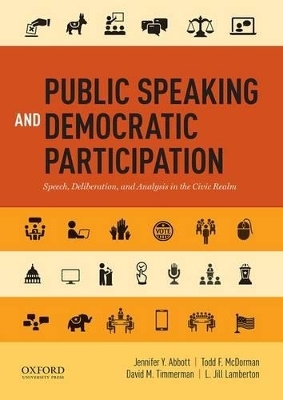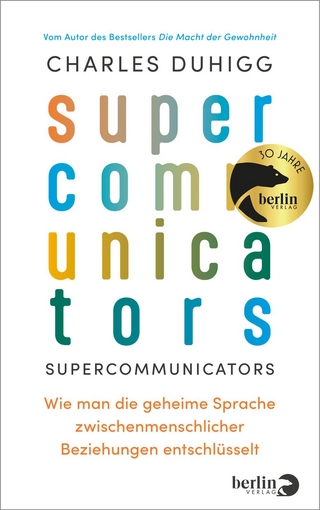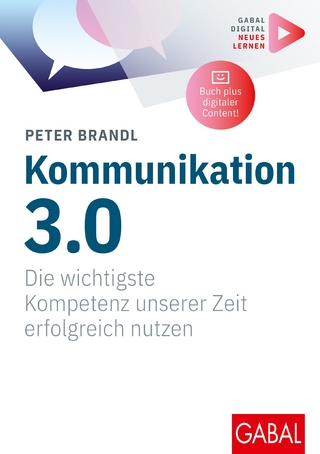
Public Speaking and Democratic Participation
Oxford University Press Inc (Verlag)
978-0-19-933859-7 (ISBN)
discourse; participate in and lead constructive discussions of community issues; and analyze public messages as an act of civic participation.By integrating the theme of civic engagement
throughout, Public Speaking and Democratic Participation offers a direct and inspiring response to the alarming decline in civic participation in the U.S. and the climate of vindictiveness in our current political culture. It equips students with the tools to reverse these tendencies and move toward a greater commitment to our shared public life.
Jennifer Y. Abbott is Associate Professor and Chair of the Rhetoric Department at Wabash College. Todd F. McDorman is Professor of Rhetoric and Senior Associate Dean of the College at Wabash College. David M. Timmerman is Dean of the Faculty and Vice President for Academic Affairs at Monmouth College. Jill Lamberton is Assistant Professor of English at Wabash College.
Preface:
CHAPTER 1. Public Speaking as the Intersection of Rhetoric and Democracy
RHETORIC AS A CIVIC ART
THE HISTORICAL RELATIONSHIP BETWEEN RHETORIC AND DEMOCRACY
Democratic Participation in the Assembly
Public Critique in a Democracy
RHETORIC AND DEMOCRACY ARE MUTUALLY REINFORCING
Rhetoric Encourages Democracy
Democracy Encourages Rhetoric
Civic Rhetoric at the Local Level
--Spotlight on Social Media: Twitter and Public Activism:
Civic Rhetoric at the Global Level
CHAPTER 2. The Landscape of Public Discourse and the Politics of Polarization
THE PROBLEMS WITH PUBLIC COMMUNICATION
The Public, the Public Sphere, and Public Discourse
Growing Concerns about the State of Our Public Communication
The Qualities of Unproductive Discourse
OBSTACLES TO PRODUCTIVE COMMUNICATION
The News Media
Incivility as Strategy
Marketing Ideas Rather Than Working toward Compromise
Reluctant Participation in Democratic Processes
CHANGING OUR PUBLIC COMMUNICATION: TOWARD PRODUCTIVE DISCOURSE
Rethinking Public Discourse
--Spotlight on Social Media: Keep it to Yourself? Politics on Facebook:
Qualities of Productive Discourse
UNPRODUCTIVE DISCOURSE AND THE ROLE OF SOCIAL PROTEST
Social Hierarchy and Policing Discourse
Social Protest as Political Strategy
CHAPTER 3. The Ethics of Public Speaking
ETHICS AND RHETORICAL ETHICS
Ethical Codes
Rhetorical Ethics
THE ETHICS OF SPEECH PREPARATION
The Deceptively Hard Work of Speech Preparation
Speech Preparation as an Ethical Demand
THE ETHICS OF SPEECH PERFORMANCE
The Ethics of Public Influence
Ethos and Five Ethical Practices of Public Communication
Avoiding Plagiarism:
Ethical Research:
Practicing Ethical and Sound Reasoning:
Ethical Language Use:
Being Responsible for the Consequences of your Public Rhetoric:
THE ETHICS OF LISTENING
Active Listening
Listening to Improve as a Speaker
Qualities of Ethical Listening
Ethical Listening Attitude:
Listening to Comprehend and Retain Information:
Listening for Message Evaluation:
--Spotlight on Social Media: Ethical Listening in the Electronic Age:
CHAPTER 4. Conducting Credible and Effective Research
RESEARCH AS INQUIRY VERSUS STRATEGY
TYPES OF SOURCES
Yourself as a Resource
Generalized Knowledge
News
--Spotlight on Social Media: Social Media Deliver and Shape the News:
Scholarship and Trade Journals
Books
Government Documents
Legal Documents
Corporate Materials
People's Opinions and Experiences
INTERVIEWS
Making a Contact
Preparing for the Interview
Conducting the Interview
ACCESS SOURCES ONLINE
Research Databases
Specialized Search Engines
Domain Name Labels
Site-Specific Searches
Simple and Advanced Field Searches
Boolean Searches
Searches Using Punctuation Marks
Saving Sources from the Internet
FOUR CRITERIA TO CONSIDER WHEN CHOOSING SOURCES
Relevance
Recency
Credibility
Bias
DOCUMENTING YOUR SOURCES
Oral Citations
Bibliographies
CHAPTER 5. Knowing and Adapting to Your Audience
THE IMPORTANCE OF AUDIENCE
AUDIENCE ANALYSIS
Audience Analysis and Advertising
Audience Analysis and the Ancients
Contemporary Audience Analysis
Demographic Factors:
Limitations to Using Demographic Factors:
Psychological Factors:
Environmental Factors:
AUDIENCE ADAPTATION
It's Still Your Message
Finding Common Ground
Using Appropriate Language
Adjusting Depth and Complexity of Content
Appealing to Deeply Held Values
Using Compelling Supporting Appeals
Selecting Credible and Familiar Sources
Adaptation, Not Manipulation
--Spotlight on Social Media: Mitt Romney and the Challenges of the Unintended Audience:
IMAGINING THE FUTURE TOGETHER
CHAPTER 6. Organizing Your Public Presentation in a Clear and Compelling Manner
THE PURPOSE OF ORGANIZATION
Four Benefits of a Well-Organized Speech
The Recursive Nature of Organization
THESIS STATEMENTS: FRAMING A CLEAR PURPOSE
A Thesis to Inform an Audience as They Prepare for Deliberation
Damien's Draft Thesis:
Damien's Revised Thesis:
A Thesis for Persuasion: Advocating Community Involvement in Animal Welfare
Ryan's Draft Thesis:
Ryan's Revised Thesis:
MAIN POINTS: THE BODY OF YOUR SPEECH
Gorgias' Main Ideas
Ryan's Main Ideas
Your Main Ideas
--Spotlight on Social Media: Twitter at Conference Presentations:
PATTERNS OF ARRANGEMENT
Categorical Arrangement
Chronological Arrangement
Spatial Arrangement
Cause-Effect Arrangement
Three Problem-Based Arrangements
Problem - Solution Arrangement:
Problem - Alternatives - Solution Arrangement:
Problem - Cause - Solution - Solvency Arrangement:
Refutative Arrangement
Monroe's Motivated Sequence
FRAMING WITH EFFECTIVE INTRODUCTIONS AND CONCLUSIONS
The Functions of Introductions
Get Attention:
Raise a Need:
Establish Credibility and Good Will:
State Your Thesis or Focal Point:
Preview the Body of the Speech:
The Functions of Conclusions
Summarize Your Main Points:
Restate Your Thesis or Focal Point:
Articulate Implications or Give Call to Action:
End Decisively:
CONNECTING SPEECH ELEMENTS
Ideas for Writing Transitions and Signposts
CHAPTER 7. Writing Effective Preparation and Presentation Outlines
THE IMPORTANCE OF OUTLINING
THE PRINCIPLES OF OUTLINING
Consistent Indentation and Symbolization
Subordination
Coordination
Parallelism
Balance
THE PREPARATION OUTLINE
Begin with the Speech Title
State Your Specific Purpose
Label and State Your Thesis
Label and Offer a Preview for the Speech
Label Your Introduction and Conclusion
Write Main Points and Sub-points in Complete Sentences
Label Transitions and Internal Summaries or Internal Previews as Signposts
Include a Bibliography
--Sample Preparation Outline--Putting Our Heads in the Game: Deliberating Concussions and High School Football:
THE PRESENTATION OUTLINE
Strive for Brevity
Maintain Indentation and Other Visual Guides
Include Delivery Notes
Format Presentation Outline for the Rhetorical Situation
--Sample Presentation (Key Word) Outline-Putting Our Heads in the Game: Deliberating Concussions and High School Football:
--Another Preparation Outline: Showing Compassion to Our Animal Friends (Persuasive Speech):
CHAPTER 8. Using Style to Harness the Power of Language
THE USES OF STYLE IN PRESENTATIONS
Clarity
Attention
Emotion
Perspective Creation
STYLISTIC DEVICES
Rhythm
Parallelism:
Repetition:
Antithesis:
Alliteration:
Visualization
Concrete Language:
Visual Imagery:
Simile:
Metaphor:
Personification:
Strengthening Argument
Irony:
Satire:
Reference to the Unusual:
Community
Inclusive Pronouns:
Gender Neutral Language:
Maxim:
Ideograph:
--Spotlight on Social Media: DePaul University Social Media Guidelines:
FRAMING
CHAPTER 9. Engaging Your Audience through Delivery and Memory
DELIVERY
Speech Anxiety is Normal
Strategies to use Prior to Speaking:
Strategies to Use During a Speech:
Strategies to Use After a Speech:
Find a Manner of Delivery that Works for You
Delivery is Situational
Your Delivery Will Develop Over Time
ELEMENTS OF DELIVERY
Vocal Delivery
Volume:
Tone:
Rate:
Pauses:
Articulation:
Pronunciation:
Vocal Fillers:
Nonverbal Delivery
Eye contact:
Facial Expressions:
Gestures and Movement:
Appearance:
Conclusions about Vocal and Nonverbal Delivery
MEMORY AND MODES OF DELIVERY
Extemporaneous Delivery
Impromptu Delivery
Memorized Delivery
Manuscript Delivery
--Spotlight on Social Media: Phil Davison Wants Your Support:
CHAPTER 10. Speaking Informatively through Deliberative Presentations
INFORMATIVE SPEAKING
The Need for Informative Speaking in Civic Affairs
--Spotlight on Social Media: Mediated Learning Communities Expand Our Understanding of Informative Speaking:
Types of Informative Speeches in a Civic Engagement Context
Instructional Speeches:
Problem-Focused Speeches:
Deliberative Presentations:
PREPARING A DELIBERATIVE PRESENTATION
Selecting a Public Controversy
Discovering a Range of Perspectives
Framing for Deliberation
Defining the Problem Fairly:
Identifying Trade-offs:
Weighing Competing Values:
Organizing and Delivering the Deliberative Presentation
LIMITATIONS AND BENEFITS OF INFORMATIVE SPEAKING
CHAPTER 11. Helping Communities Make Difficult Decisions through Deliberative Discussions
DISTINCTIVE QUALITIES OF DELIBERATIVE DISCUSSIONS
DELIBERATIVE DISCUSSIONS IN HISTORICAL CONTEXT
--Spotlight on Social Media: The Advantages and Challenges of Online Deliberative Discussions:
DELIBERATIVE DISCUSSION STRUCTURE
THE HEART OF A DELIBERATIVE DISCUSSION: WORKING THROUGH THE ISSUE
DISCUSSION LEADING
Creating a Comfortable Environment
Specific Leadership Tasks
Developing Discussion Questions
PARTICIPATING IN A DELIBERATIVE DISCUSSION
BENEFITS OF DELIBERATIVE DISCUSSIONS
CHAPTER 12. Persuading an Audience to Modify Their Beliefs, Values, or Actions
INVENTION: THE SUBSTANCE OF PERSUASION
Heuristics
Modes of Proof
THE PERSUASIVE PROCESS
Audience Analysis and Adaptation
Persuasive Goal
Framing Persuasive Efforts
Identify an Issue Worthy of Attention
Offer a Superior Response
Empower Your Audience--Provide a Means to Act
--Spotlight on Social Media: Persuasive Advocacy Using Facebook and Twitter:
CHAPTER 13. Practicing Good Reasoning through Quality Arguments
ARGUMENT AND THE TOULMIN MODEL
Classical Reasoning
Using the Toulmin Model
Arguments and Their Limits
EVIDENCE AND ITS EVALUATION
Examples
Statistics
Testimony
PATTERNS OF REASONING AND REASONING FALLACIES
Reasoning from Example
Reasoning from Analogy
Reasoning from Cause
Reasoning from Sign
Reasoning from Authority
Additional Common Fallacies
--Spotlight on Social Media: Taking Academic Debate Online:
CHAPTER 14. Designing Visual Aids to Reach an Audience
VISUAL AIDS CAN BENEFIT SPEAKERS
Visual Aids Can Increase Clarity
Visual Aids Can Summarize Ideas Quickly
Visual Aids Can Increase Audience's Attention and Recall
Visual Aids Have the Power to Affect Your Credibility as a Speaker
VISUAL RHETORIC AND CIVIC ENGAGEMENT
Images Function as Visual Rhetoric
Visual Aids and Civil Discourse
The Pitfalls of Oversimplification, Unnecessary Complexity, and Unproductive Discourse:
The Rhetoric of Visual Aids as Productive Discourse:
TYPES OF VISUAL AIDS
Presentation Software
PowerPoint:
Keynote:
Prezi:
Google Presentation:
Final Thoughts on Presentation Software:
Other Types of Visual Aids, Their Affordances, and Considerations for their Use
--Spotlight on Social Media: TedTalks: Aimee Mullins "My 12 Pairs of Legs":
VISUAL AIDS AND THE ART OF DESIGN
Additional Considerations in Artistic Design
White Space:
Font:
Color:
Ease of Processing:
Image Quality:
Slide Readability for All Audience Members:
Content Overload:
Transition and Animation Overload:
The "Ooops" Factor:
INTEGRATING THE VISUAL WITH THE ORAL PRESENTATION
Research Venue Constraints
Practice with Your Aids
Don't Read from Your Slides
Don't be Afraid of a Blank Screen
CHAPTER 15. Rhetorical Criticism as Civic Engagement
RHETORIC AND RHETORICAL CRITICISM
Rhetoric as Symbolic Action
Rhetorical Criticism
Description and Interpretation:
Evaluation:
RHETORICAL CRITICISM AS AN INTELLECTUAL DISCIPLINE
FOUNDATIONAL ELEMENTS IN RHETORICAL CRITICISM
Selecting Rhetorical Artifacts
Situating Rhetorical Acts in Context
Reading Rhetorical Artifacts
--Spotlight on Social Media: Analyzing Visual Images as Rhetorical Artifacts:
Considering Audience
EVALUATING DEMOCRATIC PRACTICE AND CIVIC ENGAGEMENT
Rhetorical Criticism as Democratic Participation
CHAPTER 16. Public Communication Analysis
LOCATING A RHETORICAL ARTIFACT
DETERMINING THE CONTEXT
DESCRIBING AND INTERPRETING THE RHETORICAL FEATURES
Argumentation
Appeals to Emotions and Loyalties
Rhetor's Credibility
Construction of the Desired Audience
Construction of the Undesired Audience
Organization
Style and Framing
Delivery
--Spotlight on Social Media: A Blog Devoted to Rhetorical Criticism of Public Communication:
EVALUATING THE RHETORICAL ARTIFACT
Did the Artifact Achieve the Rhetor's Goals? Why or Why not?
Did the Artifact Strengthen or Weaken Democratic Principles? How?
How Did the Artifact Directly Support or Hurt Democratic Principles?:
How Did the Artifact Indirectly Support or Hurt Democratic Principles?:
CHAPTER 17. Ideological Analysis
IDEOLOGICAL CRITICISM AND CIVIC PARTICIPATION
LOCATING A RHETORICAL ARTIFACT
DETERMINING THE CONTEXT OF THE RHETORICAL ARTIFACT
DESCRIBE AND INTERPRET THE ARTIFACT'S IDEOLOGICAL ASSUMPTIONS
Ideological Assumptions and Agency
Ideological Assumptions and Hegemony
Ideological Assumptions and Resistance
--Spotlight on Social Media: A Mighty Girl Blog and Facebook Posts:
EVALUATE HOW THE ARTIFACT'S IDEOLOGICAL ASSUMPTIONS ELEVATE OR CHALLENGE DEMOCRATIC PRINCIPLES
Glossary:
Notes:
Index:
| Erscheinungsdatum | 10.02.2016 |
|---|---|
| Zusatzinfo | Illustrations |
| Verlagsort | New York |
| Sprache | englisch |
| Themenwelt | Sachbuch/Ratgeber ► Beruf / Finanzen / Recht / Wirtschaft ► Briefe / Präsentation / Rhetorik |
| Sozialwissenschaften ► Politik / Verwaltung ► Politische Systeme | |
| Sozialwissenschaften ► Politik / Verwaltung ► Politische Theorie | |
| ISBN-10 | 0-19-933859-0 / 0199338590 |
| ISBN-13 | 978-0-19-933859-7 / 9780199338597 |
| Zustand | Neuware |
| Haben Sie eine Frage zum Produkt? |
aus dem Bereich


